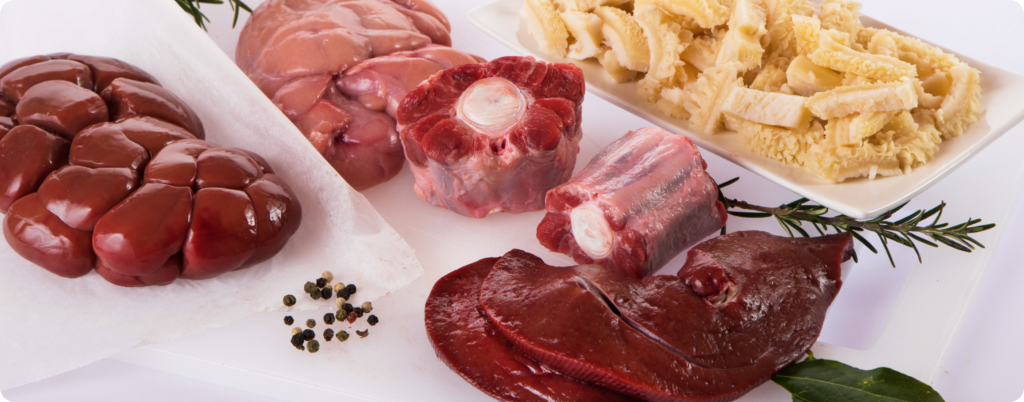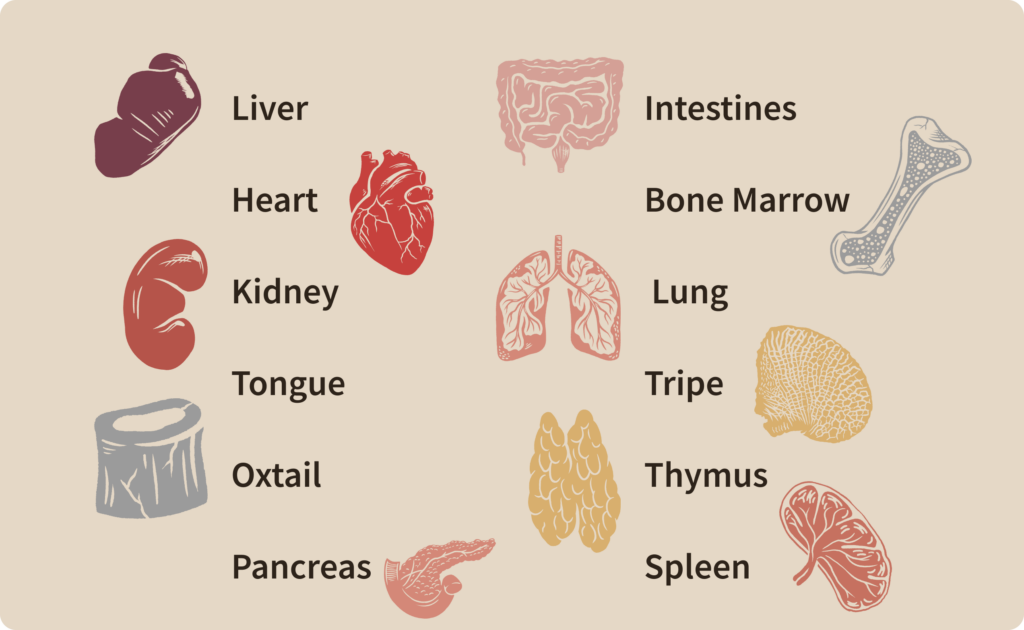PLEASE NOTE: The information in this blog is for educational purposes only. It is not a substitute for professional medical advice. Consult your healthcare provider if you’re seeking medical advice, diagnoses, or treatment.
Animal products have been closely intertwined with the human diet for millions of years (1). As an amazing source of essential nutrients, animal foods are treasured globally and throughout the animal kingdom.

While cuts of meat like fatty ribeyes or simple chicken breasts receive most of the attention nowadays, organ meats are often overlooked (or thrown away). Many don’t realize that these cuts of meat are packed with valuable nutrients that may be absent in muscle meat or popular plant foods.
In this article, we’ll discuss 10 reasons you should include organ meats in your diet. As you’ll see, small amounts of these foods can dramatically impact your well being.
Let’s dive into it!
10 Amazing Benefits of Organ Meats
Modern science is slowly beginning to unpack what people (and other animals) have understood for eons: that organ meats are extremely valuable. Here’s 10 reasons why organs are such a crucial addition to the diet.
1. Organ meats are a rich source of vitamins.

Organ meats offer a high level of vitamins A, B2, B12, and even a small amount of vitamins C and E (2, 3). Diets with high levels of these vitamins are connected to improvements in chronic disease outcomes (4).
2. Organ meats are packed with minerals.
Every kind of animal liver (beef, chicken, etc.) is a fantastic source of absorbable minerals like copper, zinc, selenium, and iron (5). These minerals can positively affect your health.
For example, copper is known to support immune system function and brain development (6).
3. Organ meats may help alleviate anemia.
Liver has been used as a strategy to combat anemia, given that it’s a low-calorie and high-protein food rich in iron, zinc, and other essential nutrients (7).
Two physicians constructed a special diet for patients with pernicious anemia. The diet revolved around iron-rich proteins such as beef liver and abundant fruits and vegetables (8).
All 45 patients “showed a prompt, rapid and distinct remission of their anemia with at least rather marked symptomatic improvement.” This special diet also improved patient red blood cell counts (9).
Another study on Egyptian children examined beef liver’s impact on anemia. A group of children (43% of whom were anemic) were fed meatballs containing liver. After 90 days, the anemia vanished in the group less than six years old and decreased to 12% for those greater than six years old (10).
4. CoQ10 is found in various organ meats.

CoQ10 is a known antioxidant with many health benefits, such as assisting energy production within your body (11). CoQ10 can be found in meat, fish, and poultry, but organ meats like liver and heart are richer sources of this antioxidant (12, 13).
5. Organ meats contain omega-3 fatty acids.
Most people think of fish as the primary source of omega 3’s (rightfully so), but organ meats can also contain DHA (14). For example, about 3.5 ounces of liver offers 80 mg of DHA.
Omega 3’s have numerous benefits and are thought to help relieve oxidative stress and inflammation (15).
6. Organ meats contain nutrients missing or lacking in plants.

Generally, vitamins from animal foods are more bioavailable than those from plants (16). Organ meat is also considered more nutrient-dense than most plant foods as it’s rich in vitamins A, B12, and choline (17).
One crucial nutrient missing in plant foods is vitamin B12, which helps create DNA (18). Liver, oysters, and clams are some of the most potent sources of this vitamin.
It’s also known that vitamin A absorption from plant foods is considered poor compared to animal sources (19). Riboflavin (vitamin B2) is found in some vegetables, but kidneys and liver are ideal sources (20).
7. Organ meats may support sexual health.
Given the level of nutrients in organ meats, it shouldn’t be surprising that these foods can help positively impact your health in numerous ways. One of the potential benefits of organ meat consumption is improved sexual health.
One study determined that men who consumed organ meats had a higher total sperm count, motility, and sperm concentration (21). Vitamin A, found in liver and other organ meats, is also important for reproduction (22).
8. Organ meats can help overcome nutrient deficiencies.
One area of organ meat research concerns nutrient deficiencies. Desiccated beef liver has been shown to help infants overcome nutrient deficits (23). Liver meatballs have also been shown to fight vitamin A deficiency in preschool children (24).
Even in wealthy countries, many individuals are missing out on adequate iron, zinc, choline, folate, selenium, and vitamins A and D (25). But eating organ meats can provide you with each of these nutrients.
9. Eating organ meats reduces food waste.
Eating organ meats is a great way to incorporate the valuable nutrients that cattle and other animals provide.
A key component of the animal-based diet is eating nose to tail. This means using as much of the animal as possible, including the meat, organs, fat, and other components that are often discarded.
10. Organ meats are more nutrient-dense than muscle meat.
Just as we saw with plant foods, organ meats also have more nutritional value than muscle meat (26). In organ meats, you’ll find higher amounts of vitamins A and B12, as well as carnitine, anserine, taurine, creatine, glutathione, and conjugated linoleic acid (CLA)(27).

The Best Organ Meats to Eat
Believe it or not, different organ meats are widely eaten worldwide. Some cultures have dishes that include the brain, tongue, and even testicles!
While this may seem odd initially, using these parts of the animal helps eliminate food waste and provides valuable nutrients that may be lacking in a steak or ground beef. When looking at the animal kingdom, it’s also common for wolves and other meat eaters to go for the organs first.
So, if you have access and enjoy the taste, consider adding these fresh organ meats to your routine:

If you travel regularly or can’t find fresh organs in your area, Heart & Soil offers a wide range of products that are great alternatives. All Heart & Soil products are sourced from regeneratively raised, grass-fed, and finished cattle and are free from hormones, pesticides, and artificial ingredients.
Stop Overlooking Organ Meats
The modern dietary situation for most people is confusing to say the least. With all of the conflicting dietary information, social media “experts”, and shady corporate interests, it can be confusing to know what you should be eating.
Thankfully, we can look back to history for guidance. One recurring theme is the immense value placed on animal foods and organ meats in particular. These foods are loaded with nutritional value that’s regularly missing from plant foods and even other cuts of meat.
Including organ meats in your diet is a simple change that can make a huge difference for your health!
Subscribe to future articles like this: